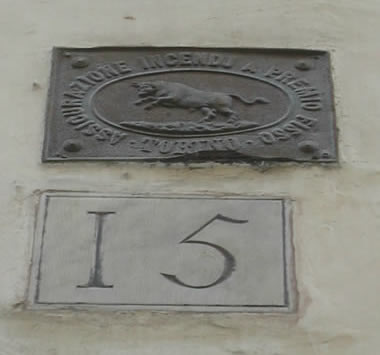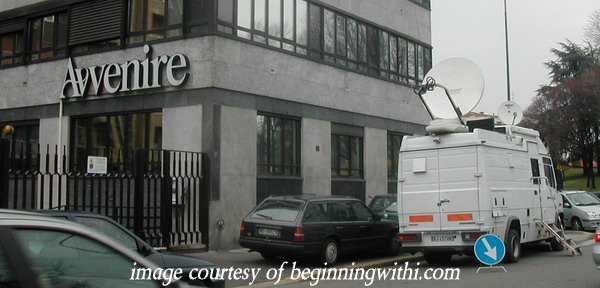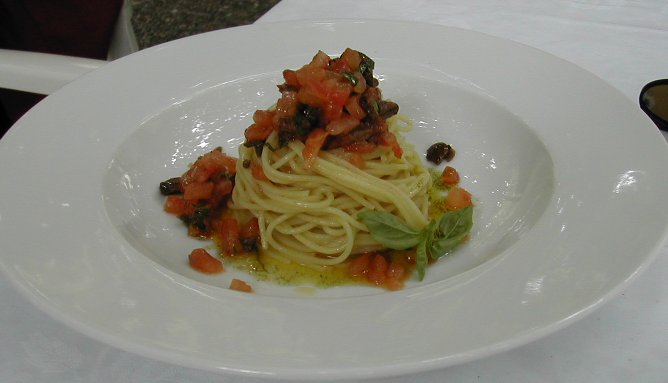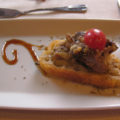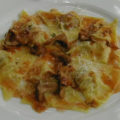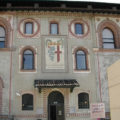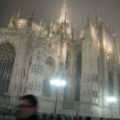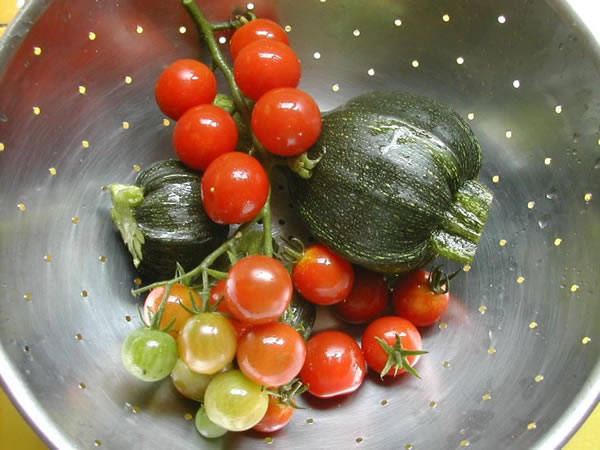^ Fresh produce from our garden. The zucchine aren’t supposed to be that shape; they had long skinny ends which I cut off because they were rotting; the uneven growth might be due to uneven watering (we’re still learning). I also need to learn to look more closely at the tomatoes before I cut them. But it makes a visually interesting assortment.
Our new home has a bit of land around it, so, for the first time in 30 years, I can plant in something bigger than a windowbox. There’s a lot to do to turn this mess into a garden, however – the previous owners neglected it terribly. For starters, since we moved here I’ve grubbed up several hundred kilos of dandelions and other weeds from the lawn. (I don’t mind. I find weeding therapeutic during times of frustration, such as phone calls to Telecom Italia.)
I planted bulbs back in October, in the bare patches left after the dandelions were removed, so we have cheerful clumps of daffodils, with hyacinths, tulips, and irises coming along later. My weeding activities have given the lawn a mangy look, but I’m reseeding it with grass and wildflowers.
Measured horizontally, our backyard would be about 10 by 12 meters. But we’re on a slope – in its natural state, this land would be almost vertical, so when the house was built, the land got terraced. There’s a piece of flat yard extending about four meters from the door of our basement-level den out towards the lake, then there’s a six-meter drop. The mass of earth (building rubble and very clayey soil) is kept in place by a stack of open cinder blocks, mostly filled with rocks and weeds (yes, my fellow Woodstockers, we have our very own khud!). There’s another three-meter terrace of flat land below, then it drops three meters (more cinder blocks) to a tiny strip (1/2 meter) of dirt abutting the neighbors’ fence. All this is traversed by a narrow staircase of more cinder blocks.
What to do with this peculiar arrangement? The top level we’ll mostly keep clear, in hopes of eventually having a lawn worth enjoying. And lawn chairs – it gets lots of sun. We’ve planted ten rose bushes along the low fence that stops people falling down to the terrace below, and yesterday I put up a low enclosure for the turtles. (Predictably, they spent most of the time trying to get out of it.) After I decide exactly where I want that to be permanently placed, we’ll put in a little pond so that they can stay out there full-time when the weather’s warm enough.
The terrace below is in the process of becoming a vegetable garden (orto). For this, I have help. We had scarcely moved into the new house last September when Mimma (the wonderful Sicilian lady who cleans and irons for us) brought her husband Domenico to have a look. Retired from factory work, Domenico is a keen gardener, maintaining their own orto somewhere near Lecco, as well as gardening for several other people.
Domenico is a very practical man: his first suggestion was to plow up everything, including the top level, and make it all into orto. I resisted this – I want a place to lounge in the sun, when I have time for such things. (And can stop myself leaping up to dig, plant, or weed.) We do have a patch of herbs in the corner by the garage, and I’ve planted green beans on the other side of the fence where the roses are (there’s just enough space between fence and drop for me to walk along). This may be unorthodox, but legumes fix nitrogens in the soil (so I’ve read), so they should be good for the roses, and of course they can climb the fence.

Down below, I’ve already planted various salad greens, with parsely, basil, and coriander in alternate rows. I am reading up on organic gardening, trying to find natural preventatives and remedies – it seems silly to go to all the trouble of planting our own veggies, and then have to spray them with nasty chemicals and wonder what we’re eating. So far I’ve read that garlic and other “smelly†plants help discourage bugs; I’ve planted garlic around the roses. I’m growing marigolds from seeds and will transplant them out to the orto when they’re bigger, as they, too, are said to have a bug-scaring smell. And nasturtiums, which not only smell bad to bugs, but can be eaten by humans (both flowers and leaves, in salads).
In a few weeks, when the weather is truly warm, we’ll buy vegetable plants – eggplant, tomatoes, zucchine, cucumbers, peppers – which Domenico will come plant for me. Yesterday he brought some sapling trees from his own orto (two figs, four hazelnuts) which he planted along the bottom of the first retaining wall; when they get bigger, they may help prevent a landslide. This whole hillside used to be a hazelnut orchard, and the neighbors still have some very nice trees, but our property was completely deforested by someone stupid, and is therefore prone to slippage.
The rows of cinder blocks are offset from each other and stick out just enough to make little planters, so I’m slowly filling them up with odds and ends: two miniature carnation plants, small succulents that will expand to fill their spaces, and wild strawberries. The property is full of strawberry plants, but they have a tendency to grow where they will get stepped on, so I’m transplanting them to the cinder blocks, which should make perfect strawberry planters.
…and I could go on all day, obviously. I’d forgotten how much I love gardening, it’s been so long since I had a real opportunity to do it. I like watching things grow. And having an orto is very much an Italian tradition – anyone who has a patch of land, no matter how small, plants things that they can eat. Part of eating good food is having it fresh, and it doesn’t get any fresher than right out of your own garden. I’m looking forward to putting own on produce on our dining table this summer!
May 11, 2005
I should have been grateful for the unusually long winter. Now spring has set in with a vengeance, and with it, allergies. We had a beautiful weekend, and I would have loved to be out gardening, but I was stuck in my room with my clean-air machine, taking allergy pills and eyedrops (probably more of both than I should), and nonetheless in sneezing, eye-burning misery. Oh, well. At least I have a nice view of all the burgeoning greenery from my window…

